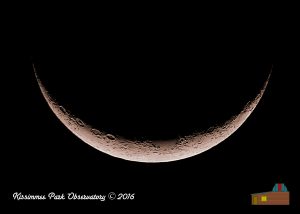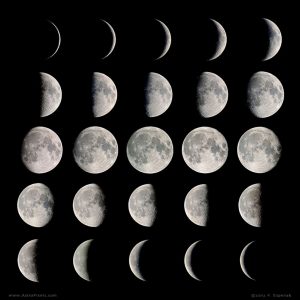The phases of the moon are Astronomy 101, but are so important when it comes to understanding the moon. Earth’s natural satellite has such a significant impact on how life on Earth is lived. Each phase tells a story about our universe.
 The light of the moon is actually sunlight reflecting off the moon’s surface. The moon doesn’t radiate any glow of its own but only the glow created by the sun. The moon is a gray, silent sphere with no atmosphere and is covered in craters.
The light of the moon is actually sunlight reflecting off the moon’s surface. The moon doesn’t radiate any glow of its own but only the glow created by the sun. The moon is a gray, silent sphere with no atmosphere and is covered in craters.
Luna is glorious in all its phases, yet the moon is not the only object in space that has phases. Earth has phases as well, if you landed on the moon, of course. As Earth orbits around the sun, its shadow creates a different image during different orbital positions, just like what we see with the moon.
Scientists categorize the moon using eight phases and those phases are sub-categorized by primary moon phases and interstitial moon phases.
Primary moon phases are the new moon, first quarter, full moon and last quarter. Interstitial moon phases are the waxing crescent, waxing gibbous, waning gibbous and waning crescent.
1. New Moon
A new moon is no moon, at least that’s what it looks like from Earth. A new moon also symbolizes a rebirth. During this time, the moon is in a conjunction with the sun. The Earth, Moon and Sun are aligned in that order. The moon and sun rise, set and transit the sky at the very same time but exactly opposite from one another. The reason why we can’t see the moon during this time is because the light side of the moon is turned away from Earth, thus only revealing the dark side of the moon. The period from one new moon to the next new moon is called a lunation.
2. Waxing Crescent
The waxing crescent is the next phase after a lunar conjunction. The moon has orbited out of alignment from conjunction that the sun rays catch the crescent portion of the illuminated face of the moon. The waxing crescent is also called a “young moon” as it’s the first glimpse after the rebirth of a new moon. The waxing crescent begins to glow in the western sky just after sunset. Scientists use the term ‘waxing’ in that the moon is growing toward a full moon.
3. First Quarter Moon
This phase is unofficially known as the half moon, however, the proper scientific term is a “first quarter” moon. Though from Earth it looks like the entire moon is half lit, in essence there’s another half lit portion behind what we see, which is the quarter we see illuminated. Also, the moon has orbited around the Earth by one quarter. The first quarter moon rises at noon and sets at midnight. During this quarter, you’re able to see the moon just before sunset.
4. Waxing Gibbous
This moon phase is approaching full moon. There’s a curvature cut off that just snips it from being the full moon that it will eventually become. This moon phase can also be seen before sunset as it rises in the east between noon and sunset.
 5. Full moon
5. Full moon
Everyone’s favorite moon phase except if you’re hoping to see a meteor shower or star hopping for deep sky objects. The full moon is the opposite occurrence of the new moon. Which means the moon is in a lunar opposition to the sun with Earth snug in the middle. The Sun, Earth and Moon are perfectly aligned. The full moon rises when the sun sets and sets when the sun rises.
6. Waning Gibbous
The waning gibbous is also an imperfect full moon but is on it’s way to becoming yet another dark and empty new moon. The waning gibbous rises late in the night and hangs around a bit in the morning hours. It’s a lovely site to see the moon still hovering over when you are on the way to seize the day. Scientists label this moon waning because it is going from a full moon to a new moon.
7. Third Quarter Moon
Also known as the last quarter moon, this phase represents the moons journey around the earth at 3/4 almost complete. The last quarter moon rises late in the night, around midnight and the illuminated half portion of the moon is facing down. This moon phase offers a good resource to Earth’s orbit. During the early morning hours, the third quarter moon represents Earth’s orbit. In other words, when you see the third quarter moon in predawn hours, Earth will be heading in that direction as the Earth continues on its orbital journey.
8. Waning Crescent
Opposite of the young moon, the waning crescent is sometimes referred to as the old moon. This phase is waning closer to the rebirth of a new moon and because of this, the lighted portion of the moon is facing away from the Earth leaving only a sliver of illumination left. The waning crescent is seen during the dawn hours, give or take.
Conclusion
There you have it, the eight phases of the moon. The moon takes about 29.5 days to orbit around the Earth so each phase of the moon can last roughly 3 days each. You will notice each phase gradually wane and wax depending on which phase it’s at in the lunar cycle.
By Donna Morgese – KPO staff writer

